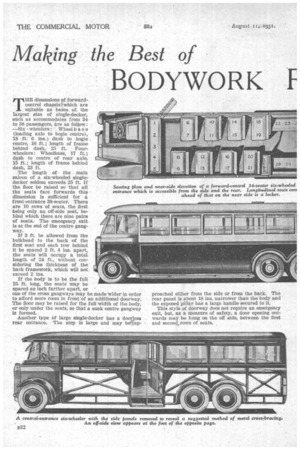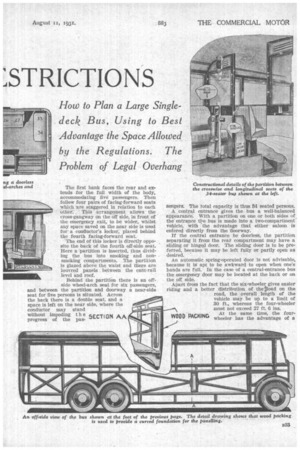Maktrig the Best of
Page 46

Page 47

Page 48

If you've noticed an error in this article please click here to report it so we can fix it.
BODYWORK F :STRICTIONS
How to Plan a Large Single decl Bus, Using to Best Advantage the Space Allowed by the Regulations. The Problem of Legal Overhang
THE dimensions of forwardcontrol chassis,which are suitable as bases of, the largest size of single-decker, such as accommodates from 34 to 38 passengers, are as follow : —Six wheelers: Wheelb a s e (leading axle to bogie centre), 18 ft. 6 ins. :. da.sh to bogie centre, 16 ft.; length of frame behind dash, 25 • ft. Fourwheelers : WheelhaSe, 17 ft.; daSh to centre of rear axle, 15 ft.; length of frame behind dash, 28 ft.
The length of the main saloon of a six-wheeled singledecker seldom exceeds 25 ft. If the floor be raised so that all the seats tats, forwards this dimension is sufficient for a front-entrance 38-seater. There are 10 rows of seats, the first being only an off-side seat, behhici which there are nine pairs of seats. The emergency exit is at the end of the centre gangway.
If 3 ft. be allowed from the bulkhead to the back of the first seat and each row behind it be spaced 2 ft. 4 ins, apart, the seats will occupy a total length of 24 ft., without con
sidering the thickness of the•back framework, which will not
exceed 2 ins.
If the body is to be the full 25 ft. long, the seats may be spaced an inch farther apart, or .
one of the cross gangways may be made wider in order to afford more roam in front of an additional doorway. The floor may be raised for the full width of the body, or only under the seats, so that a sunk centre gangway is formed.
Another type of large single-decker has a dot:less rear entrance. The step is large and may bap
preached either from the side or from the back. The rear panel is about 18 ins, narrower than the body and the exposed pillar has a large handle secured to it.
This style of doorway does not require an emergency exit, but, as a measure of safety, a door opening outwards may be hung on the oft side, between the first and second, rows of seats.
The first bank faces the rear and extends for the full width of the body, accommodating five passengers. Then follow four pairs of facing-forward seats which are staggered in relation to each Other: , This arrangement alloWs the cross-gangway on the off side, in front of the emergency exit; to be wider, whilst any space saved on the near side is used fora conductor's locker, placed behind the fourth facing-forward seat.
The end of this locker is directly opposite the back of the fourth off-side seat. Here a partition is inserted, thus dividing the bus into smoking and nonsmoking compartments. The partition is glazed above, the waist and there are louvred panels between the cant-rail• level and roof.
Behind the partition there is an offside wheel-arch seat for six passengers, and between the partition and doorway a near-side seat for five persons is situated. Across the back there is a double seat, and a space is left on the near side, where the conductor may stand without impeding th
— e SECTI UN AA progress of the pas
se/Igen': The total capacity is thus 34 seated persons.
A central entrance gives the bus a well-balanced appearanCe: With a partition on one or both sides of the entrance the bus is made into a two-compartment vehicle, with the advantage that either saloon is entered directly from the doorway.
If the central entrance be doorless, the partition separating it from the rear compartment may have a sliding or hinged door. The sliding door is to be preferred, because it may be left fully or partly open as desired.
An automatic spring-operated door is not advisable, lbecause it is apt to be awkward to open when one's hands are full. In the case of a central-entrance bus the emergency door may be located at the back or on the off side.
Apart from the fact that the six-wheeler gives easier riding and a better distribution of thelload on the road, the overall length of the vehicle may be up to a limit of 30 ft., whereas the four-wheeler must not exceed 27 ft. 0 ins.
WOOD PACKING At the same time, the fourwheeler has the advantage of a
smaller wheel-arch and the proportion of longitudinal to crosswise seats is more favourable. Furthermore, the 7-24ths overhang of a four-wheeler includes only half the wheel-arch, whereas with the six-wheeler it embraces the whole of the second arch—a point that should be remembered.
If a four-wheeler be 27 ft. 6 ins, long overall it may have an overhang beyond the rear axle of 8 ft. 01 in. Assuming that the wheels are 3 ft. in diameter and 61 ins, is allowed for the wing clearance, then half the wheel-arch will be 2 ft. 01 in. long and there will be 6 ft. remaining which may be _devoted to the dis
posal of a rear side entrance and any rear seating required.
With the 30-ft. six-wheeler which has an overhang of 8 ft. 9 ins, from a point 4 ins, behind the bogie centre, about 3 ft. 6 ins, has to be deducted for the second wheel-arch. Thus 5 ft. 3 ins, of body length is left for the rear entrance and seats, or 9 Ins, less than the corresponding measurement oT the shorter four-wheeler.
It would appear, therefore, that in order to obtain the full advantage of the length of the six-wheeler, the main entrance should be in front of the wheel-arch.




























































































